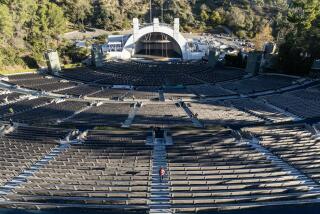Bowlers Hope to See Alley Spared
- Share via
It was another busy night at the Hollywood Star Lanes and try as he might, 69-year-old Johann Schuessler couldn’t keep up with his wife, Aldona, 57. She’s the bowler in the family.
In the next lane, Bill Kingsbury, Lee Denton and Cletus Young were enjoying yet another Saturday outing, knocking over a few pins and laughing at one another’s jokes.
Also in the crowd was 26-year-old Ben Cutter, who suddenly became a center of attention for bowling an almost unheard-of--at least in this crowd--game of 200.
“If I could ever do this again,” Cutter muttered, admitting he usually shoots half that score.
But overriding the scene was the knowledge that the fun at the Hollywood Star Lanes is coming to an end.
The landmark bowling alley, established in 1960, is scheduled to close Aug. 7, the result of an eminent domain proceeding by the Los Angeles Unified School District to take over the 3-acre parcel where the bowling alley sits along Santa Monica Boulevard.
Faced with an expanding enrollment that threatens to surpass 748,000 students next fall, the administrators of the nation’s second-largest school district have started a new facilities program to relieve overcrowded conditions at many of their campuses.
They say the building program, especially focused in the densely congested area in the city’s central district stretching north from Wilshire Boulevard to east Hollywood, can relieve the overcrowding.
District officials say that as many as 158 construction projects are scheduled to deal with the growing enrollment.
At Ramona Elementary School, about three blocks from Star Lanes, 1,200 students are enrolled at the small campus; about 300 others take buses to as far away as the San Fernando Valley because there is no room for more.
Officials plan to tear down the bowling alley and build 26 classrooms to augment the space at Ramona.
For several years, district officials have talked with Sam Barnese, Star Lanes’ owner, about acquiring the property, but no agreement has been reached. District officials and Barnese wouldn’t say how much money was offered during the negotiations. In a recent interview at the alley, Barnese acknowledged that the district made a “seven-figure” offer but refused to elaborate.
At the 32-lane bowling alley, none of the regulars was against education or the idea of new classrooms at Ramona. Still, they were upset that a favorite hangout, where a movie star is occasionally sighted, must close.
“I think it’s reprehensible,” said Young, 67, a regular who admits to an average of 165. “I taught my daughter how to bowl here. I didn’t even know it was closing. My daughter sent me an e-mail [about it] from the East Coast.”
“I think it stinks,” chimed in Aldona Schuessler. “They don’t need this place for a school.”
The Star Lanes, where numerous movies, including “The Big Lebowsky,” were filmed, is a throwback to an era when bowling alleys were plentiful and games were scored with pencils. Only in recent years was electronic scoring introduced at Star Lanes, thanks in part to profits earned from the Coen brothers’ movie.
What peeves many at Star Lanes is the apparent contradiction of abolishing a popular gathering place for families and young people--especially because the number of bowling alleys in greater Los Angeles is dwindling--to build additional classrooms.
“This just isn’t another bowling alley,” said Star Lanes waitress Antonella Cannalire, who hails from northern Italy. “There are very few places like this, where actors, young people, families, people from Australia [and] New Zealand can get together.”
Though Barnese seems resigned to the alley’s closing, other employees are fighting to keep it open.
Waitress Ziggy Kruse, who is from Hamburg, Germany, said her petition drive to save Star Lanes has so far netted more than 3,000 signatures. She and others have set up an e-mail address, [email protected], to gain support.
Kruse said she and other supporters of the alley met recently with City Councilman Eric Garcetti, who represents the area, to press their case. Their persistence has paid off; they’ll have a face-to-face meeting, scheduled for Monday, in Garcetti’s office with school board President Caprice Young.
According to district officials, however, the effort to save the bowling alley might be too little, too late.
Young, who represents the area, said district officials used a site-selection process that included representatives of community-based organizations and parents who have children at Ramona. “There was a consensus about this site,” she said, noting that there were few complaints about the decision to acquire the property.
Only now, she said, has opposition surfaced because the district has initiated eminent domain proceedings--the procedure by which a government agency can take over private property if an owner refuses to sell.
“I’ve gotten 30 to 40 calls about this, and I completely understand because I’m a bowling widow,” said Young, whose husband has a 200 average. “I would rather not take the bowling alley, but that area is that squeezed in [by surging enrollment].”
On the recent Saturday night, patrons mostly growled their displeasure at the school district’s plans.
Only Cutter, the young hipster who bowled a 200 game earlier, seemed to understand the dilemma facing the district.
“I’m a liberal Democrat, and I believe in education,” he said. “I would hate to see this place go, but I didn’t sign the petition. My friends signed, but I didn’t.”
More to Read
Sign up for Essential California
The most important California stories and recommendations in your inbox every morning.
You may occasionally receive promotional content from the Los Angeles Times.










